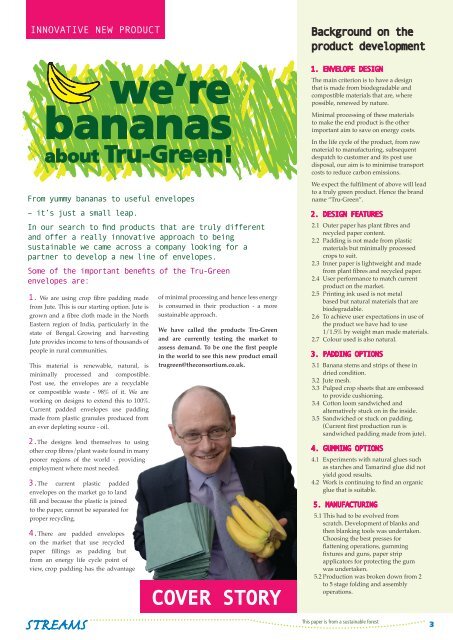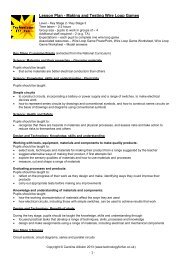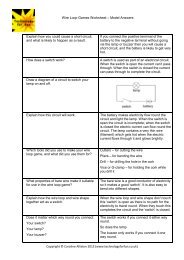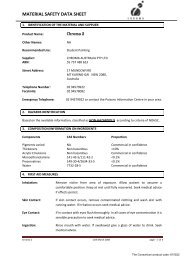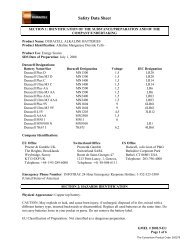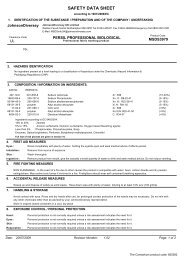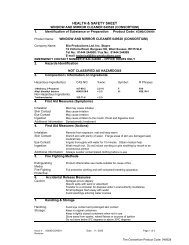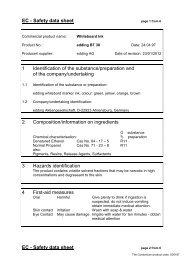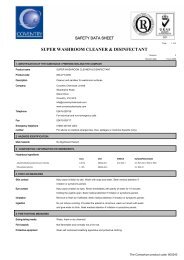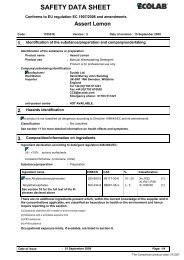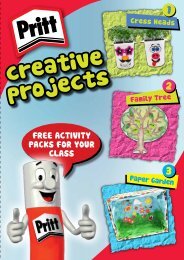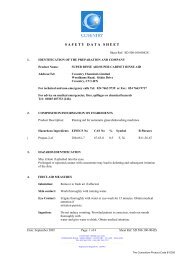INNOVATION - The Consortium
INNOVATION - The Consortium
INNOVATION - The Consortium
You also want an ePaper? Increase the reach of your titles
YUMPU automatically turns print PDFs into web optimized ePapers that Google loves.
InnOvaTIve neW PrODuCT Background on the<br />
product development<br />
we’re<br />
bananas<br />
about Tru-Green!<br />
From yummy bananas to useful envelopes<br />
– it’s just a small leap.<br />
In our search to find products that are truly different<br />
and offer a really innovative approach to being<br />
sustainable we came across a company looking for a<br />
partner to develop a new line of envelopes.<br />
Some of the important benefits of the Tru-Green<br />
envelopes are:<br />
1. We are using crop fibre padding made<br />
from Jute. This is our starting option. Jute is<br />
grown and a fibre cloth made in the North<br />
Eastern region of India, particularly in the<br />
state of Bengal. Growing and harvesting<br />
Jute provides income to tens of thousands of<br />
people in rural communities.<br />
This material is renewable, natural, is<br />
minimally processed and compostible.<br />
Post use, the envelopes are a recyclable<br />
or compostible waste - 98% of it. We are<br />
working on designs to extend this to 100%.<br />
Current padded envelopes use padding<br />
made from plastic granules produced from<br />
an ever depleting source - oil.<br />
2.<strong>The</strong> designs lend themselves to using<br />
other crop fibres/plant waste found in many<br />
poorer regions of the world - providing<br />
employment where most needed.<br />
3.<strong>The</strong> current plastic padded<br />
envelopes on the market go to land<br />
fill and because the plastic is joined<br />
to the paper, cannot be separated for<br />
proper recycling.<br />
4.<strong>The</strong>re are padded envelopes<br />
on the market that use recycled<br />
paper fillings as padding but<br />
from an energy life cycle point of<br />
view, crop padding has the advantage<br />
of minimal processing and hence less energy<br />
is consumed in their production - a more<br />
sustainable approach.<br />
We have called the products Tru-Green<br />
and are currently testing the market to<br />
assess demand. To be one the first people<br />
in the world to see this new product email<br />
trugreen@theconsortium.co.uk.<br />
COver STOrY<br />
1. enveLOPe DeSIGn<br />
<strong>The</strong> main criterion is to have a design<br />
that is made from biodegradable and<br />
compostible materials that are, where<br />
possible, renewed by nature.<br />
Minimal processing of these materials<br />
to make the end product is the other<br />
important aim to save on energy costs.<br />
In the life cycle of the product, from raw<br />
material to manufacturing, subsequent<br />
despatch to customer and its post use<br />
disposal, our aim is to minimise transport<br />
costs to reduce carbon emissions.<br />
We expect the fulfilment of above will lead<br />
to a truly green product. Hence the brand<br />
name “Tru-Green”.<br />
2. DeSIGn FeaTureS<br />
2.1 Outer paper has plant fibres and<br />
recycled paper content.<br />
2.2 Padding is not made from plastic<br />
materials but minimally processed<br />
crops to suit.<br />
2.3 Inner paper is lightweight and made<br />
from plant fibres and recycled paper.<br />
2.4 User performance to match current<br />
product on the market.<br />
2.5 Printing ink used is not metal<br />
based but natural materials that are<br />
biodegradable.<br />
2.6 To achieve user expectations in use of<br />
the product we have had to use<br />
1/1.5% by weight man made materials.<br />
2.7 Colour used is also natural.<br />
3. PaDDInG OPTIOnS<br />
3.1 Banana stems and strips of these in<br />
dried condition.<br />
3.2 Jute mesh.<br />
3.3 Pulped crop sheets that are embossed<br />
to provide cushioning.<br />
3.4 Cotton loom sandwiched and<br />
alternatively stuck on in the inside.<br />
3.5 Sandwiched or stuck on padding.<br />
(Current first production run is<br />
sandwiched padding made from jute).<br />
4. GummInG OPTIOnS<br />
4.1 Experiments with natural glues such<br />
as starches and Tamarind glue did not<br />
yield good results.<br />
4.2 Work is continuing to find an organic<br />
glue that is suitable.<br />
5. manuFaCTurInG<br />
5.1 This had to be evolved from<br />
scratch. Development of blanks and<br />
then blanking tools was undertaken.<br />
Choosing the best presses for<br />
flattening operations, gumming<br />
fixtures and guns, paper strip<br />
applicators for protecting the gum<br />
was undertaken.<br />
5.2 Production was broken down from 2<br />
to 5 stage folding and assembly<br />
operations.<br />
This paper is from a sustainable forest


